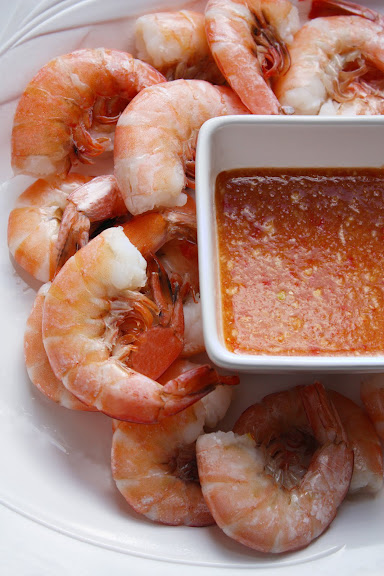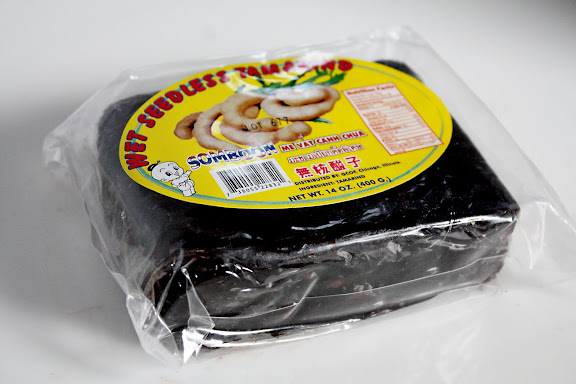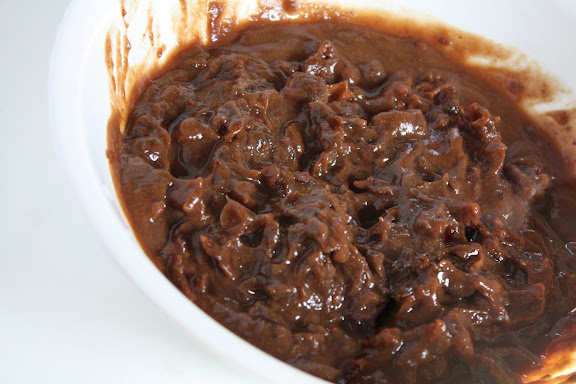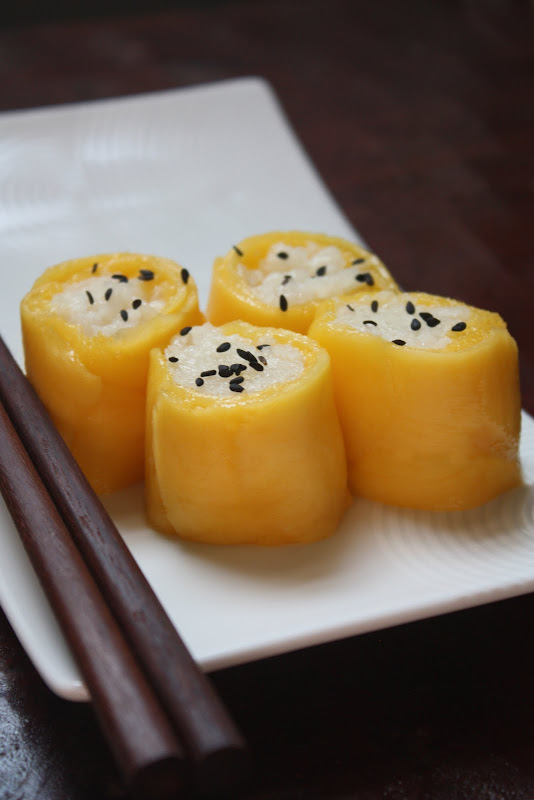
With the mango season fast approaching and the good Ataulfo (sometimes labeled Manila) mangoes popping up here and there, I thought I would give my old Thai sweet coconut sticky rice and mango recipe a revisit and a makeover.
I won’t lie to you. Turning the famous Thai duo into sushi rolls does absolutely nothing in improving the taste; it only makes it more fun and interesting.
Truth: Thai coconut sticky rice and mango, when done right, is heavenly even if it’s served on a plastic ashtray. Thai coconut sticky rice and mango, when done horribly, will be appalling even if it’s served in a Lladró bowl.
To succeed at sweet coconut sticky rice with mango, you need to start with the right ingredients:
 You need to use the right type of mango at the right stage of ripeness following the instructions on how to choose the right mango for Thai coconut sticky rice. This, in my most firmly-held and absolutely unswayable opinion, is the most important thing. A perfectly ripe, sweet-as-honey mango will save even a less-than-perfect batch of coconut sticky rice.
You need to use the right type of mango at the right stage of ripeness following the instructions on how to choose the right mango for Thai coconut sticky rice. This, in my most firmly-held and absolutely unswayable opinion, is the most important thing. A perfectly ripe, sweet-as-honey mango will save even a less-than-perfect batch of coconut sticky rice.
On the contrary, a perfectly-executed batch of coconut sticky rice will put on sackcloth, bury its head in ashes, and curse the day it was born if you pair it with a tart, stringy, tasteless mango. And while it’s possible to adjust the taste of the coconut sticky rice, it’s impossible to do anything to improve the taste and texture of a subpar mango.
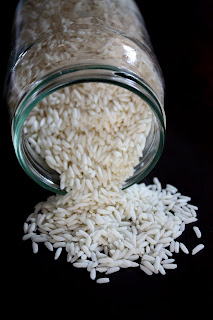 You also need to use the right type of sticky rice. The term, “sticky rice,” is too vague and used to refer to all kinds of high-starch, short-grain rice. The kind of sticky rice you want to use for this dessert is the long-grain, glutinous rice that is heavily used in Southeast Asian cuisine, especially Thai, Laotian, and Vietnamese.
You also need to use the right type of sticky rice. The term, “sticky rice,” is too vague and used to refer to all kinds of high-starch, short-grain rice. The kind of sticky rice you want to use for this dessert is the long-grain, glutinous rice that is heavily used in Southeast Asian cuisine, especially Thai, Laotian, and Vietnamese.
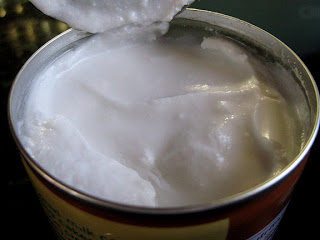 This is not the most important factor, but it certainly does help when you use quality ingredients. Chaokoh is my favorite brand of canned coconut milk. I like its high fat content which is head and shoulder above the many brands out there that are either anemic or slimy. Low-fat coconut milk is not recommended.
This is not the most important factor, but it certainly does help when you use quality ingredients. Chaokoh is my favorite brand of canned coconut milk. I like its high fat content which is head and shoulder above the many brands out there that are either anemic or slimy. Low-fat coconut milk is not recommended.
 Then when it comes to presentation, knowing how to peel and slice a very, very ripe mango is helpful. Tastewise, you can hold a ball of the coconut sticky rice in one hand, a peeled whole mango in the other, and take bites from each alternately and it won’t make a difference. But if presentation means anything to you, you may want to consider the Thai way of peeling and slicing a ripe mango. If you’ve been to Thailand, you’ll notice that the traditional way of presenting the mango is to “fillet” it and cut the fillet crosswise. No superfluous gadgets required; just a sharp paring knife and some dexterity will do.
Then when it comes to presentation, knowing how to peel and slice a very, very ripe mango is helpful. Tastewise, you can hold a ball of the coconut sticky rice in one hand, a peeled whole mango in the other, and take bites from each alternately and it won’t make a difference. But if presentation means anything to you, you may want to consider the Thai way of peeling and slicing a ripe mango. If you’ve been to Thailand, you’ll notice that the traditional way of presenting the mango is to “fillet” it and cut the fillet crosswise. No superfluous gadgets required; just a sharp paring knife and some dexterity will do.
 Then, of course, once you got all the ingredients and have been armed with the knowledge of how to handle them, making Thai Sweet Coconut Sticky Rice with Mango is very easy.
Then, of course, once you got all the ingredients and have been armed with the knowledge of how to handle them, making Thai Sweet Coconut Sticky Rice with Mango is very easy.
The sushi idea isn’t originally mine. I once had this dessert served in a similar way (the rice is outside, covering the fruit) at the now-closed Vong’s, by the famed Jean-Georges Vongerichten, in Chicago. It was made with out-of-season mango and some mushy raspberries, and I remember feeling so very disappointed. But at least, I gained an idea on how to serve Thai coconut sticky rice and mango in a fun, whimsical way.
First, you need to peel a ripe mango and slice it thinly lengthwise, with the knife blade on its side parallel to the pit. This is done more easily with a mandoline. If you don’t have a mandoline, make sure your knife is so sharp it can cut a cutting board in half. Without a super sharp knife, you really can’t pull this off.
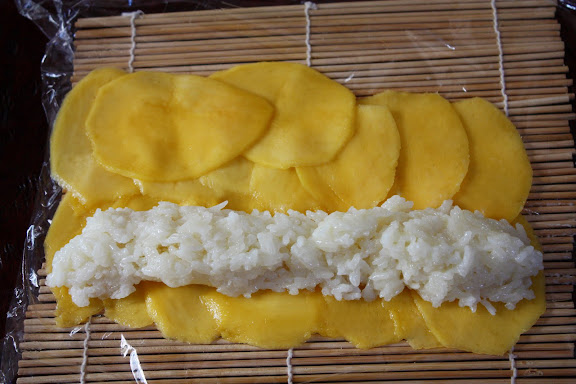
Then on a sushi mat, lined with a piece of plastic wrap, arrange the mango slices, overlapping, to form a 5×8 rectangle. Scoop prepared sweet coconut sticky rice onto the mango slices as shown.

Then very gently and carefully roll everything up sushi-style, making sure the rice is entirely encased by the mango slices. Using the sushi mat, lightly squeeze the roll to get rid of air pockets. Gently remove the plastic wrap and cut the roll crosswise into 1-inch pieces.
Sprinkle some black sesame seeds on top (traditionally, fried hulled mung beans are used as the topping), if desired. Whatever you do, don’t pop these rolls into the refrigerator. They need to be made fresh and served right away. You can keep them at room temperature, covered, for an hour or so. But refrigeration will cause the rice to harden, and reheating it along with the fresh mango wrapper in inadvisable.







